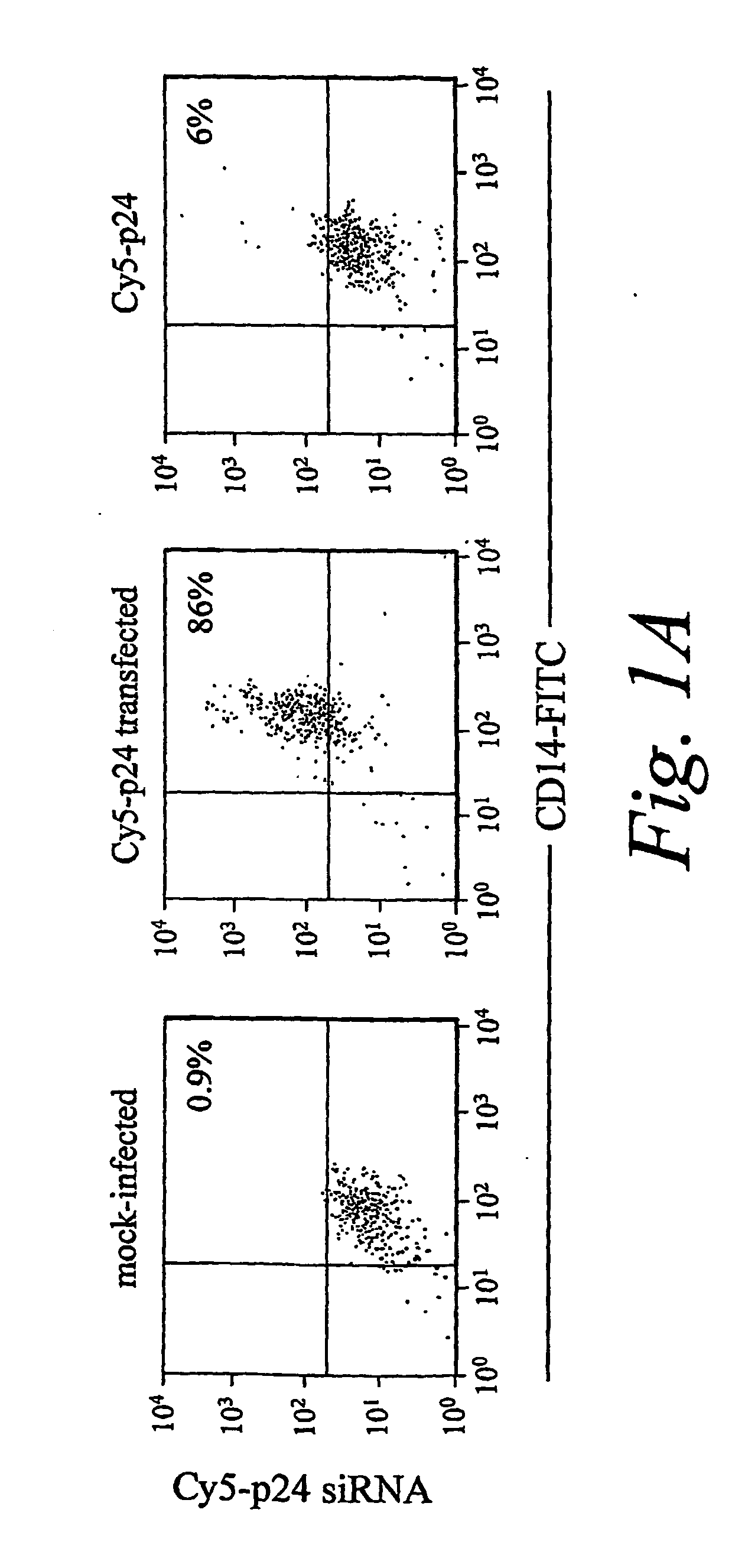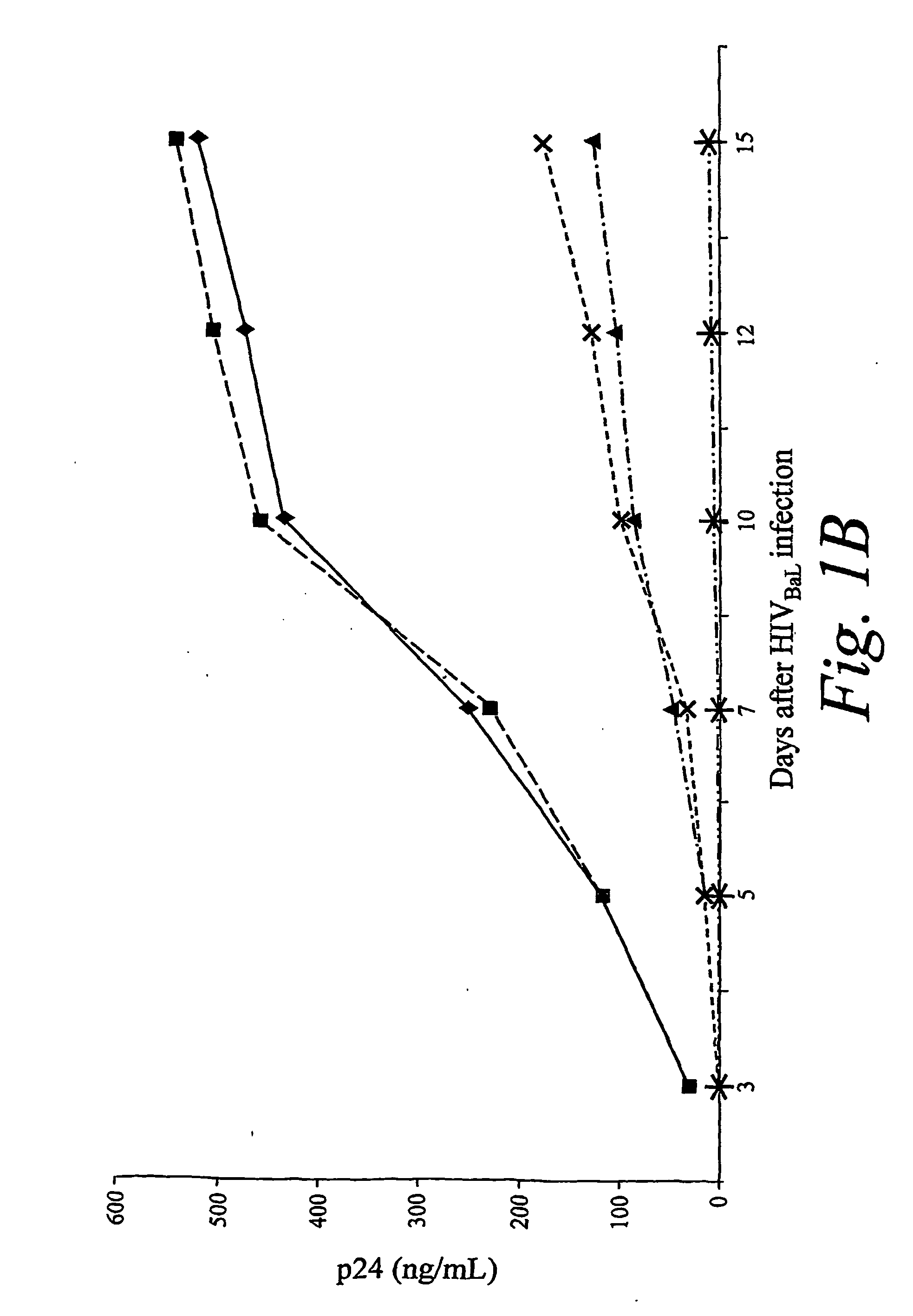Inhibition of gene expression using rna interfering agents
a technology of interfering agents and gene expression, applied in the direction of biocide, drug composition, peptide/protein ingredients, etc., can solve the problems of neoplastic growth and eventual death, opportunistic infections, and major global health problems such as aids, to achieve the effect of suppressing infection and/or replication
- Summary
- Abstract
- Description
- Claims
- Application Information
AI Technical Summary
Problems solved by technology
Method used
Image
Examples
example 1
Sustained siRNA-Mediated HIV Inhibition in Primary Macrophages
[0127] Synthetic 21-23 nucleotide siRNA duplexes suppress HIV replication in human cell lines and activated CD4−T cells (Jacque, J. M., et al. (2002) Nature 418, 435-8; Coburn, G. A. & Cullen, B. R. (2002) J. Virol 76, 9225-31; Novina, C. D. et al. (2002) Nat Med 8, 681-6; Lee, N. S. et al. (2002) Nat Biotechnol 20, 500-5). However, the silencing effect of siRNAs in these actively replicating cells peaks around 96 hours, but tapers off thereafter and is completely lost by day 9 (Novina, C. D. et al. (2002) Nat Med 8, 681-6; Tuschl, T. (2002) Nat Biotechnol 20, 446-8), presumably because of siRNA dilution with cell division or degradation inside the cell (Ullu, E., et al. (2002) Philos Trans R Soc Lond B Biol Sci 357, 65-70). Macrophages are terminally differentiated, non-dividing cells that constitute a significant reservoir for HIV-1 in vivo (Sherman, M. P. & Greene, W. C. (2002) Microbes Infect 4, 67-73; Meltzer, M. S....
example 2
Development of an HIV Microbicide
[0143] Heterosexual transmission is the leading cause of new HIV infections worldwide, with transmission from males to females occurring much more efficiently than vice versa. Sexual transmission of HIV occurs when cell-free or cell-associated virus infects cells primarily via the CCR5 co-receptor expressed on macrophages, dendritic cells (DC) and activated T lymphocytes (Alkhatib G, et al. (1996) Science, 272, 1955-1958; Huang Y, et al. (1996). Nat Med, 2, 1240-1243; Zhu T, et al. (1996). J Virol, 70, 3098-3107). In recently infected donors, infection with HIV using the CCR5 co-receptor greatly predominates over CXCR4-using virus (>90%), even when subjects are exposed to both types of virus (Huang Y, et al. (1996). Nat Med, 2, 1240-1243; Zhu T, et al. (1996). J Virol, 70, 3098-3107). Although semen contains as many as 107 viral particles / ml, the concentration of infectious virus is about 3 logs less (Dyer J R, et al. (1996). J Virol Methods, 60, 16...
PUM
| Property | Measurement | Unit |
|---|---|---|
| molecular weight | aaaaa | aaaaa |
| length | aaaaa | aaaaa |
| Fluorescent microscopy | aaaaa | aaaaa |
Abstract
Description
Claims
Application Information
 Login to View More
Login to View More - R&D
- Intellectual Property
- Life Sciences
- Materials
- Tech Scout
- Unparalleled Data Quality
- Higher Quality Content
- 60% Fewer Hallucinations
Browse by: Latest US Patents, China's latest patents, Technical Efficacy Thesaurus, Application Domain, Technology Topic, Popular Technical Reports.
© 2025 PatSnap. All rights reserved.Legal|Privacy policy|Modern Slavery Act Transparency Statement|Sitemap|About US| Contact US: help@patsnap.com



